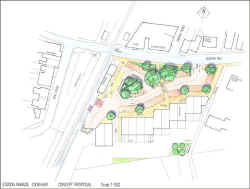
Report of the Working Group On Business and Economy
6. APPENDICES
| MAIN REPORT INDEX | BUSINESS AND ECONOMY CONTENTS |
6.1 Summary of information for Healthcheck
6.2 Breakdown of businesses registered in the Cookhams
6.3 Questionnaire response data summary
6.4 Artistís visualisation of a future design for the Station Parade
6.1 Health-check summary Ė Business and the Economy in Cookham
6.1.1. Employment.
-
There is more or less full employment in Cookham.
-
Employers do not complain of lack of labour locally. Many workers travel into Cookham daily and the rail link is important service.
-
Firms generally are bullish about future prospects
6.1.2. Business support
-
There are limited facilities for business meetings and conferences in Cookham with the notable exception of the comprehensive facilities at the CIM. The newly opened Training/Conference facility at the Odney Club is for the exclusive use of JLP (a planning condition.)
-
There is only 1 bank - Nationwide Building Society, but it does not provide comprehensive business account management.
-
From our research we perceive a need for a location/facility within the village to provide business support (especially ICT) for home-workers.
-
There is also a desire and need for local business networking opportunities - the only one that meets currently is the Cookham Bridge Rotary Club. However there is an informal local meeting of business people at the Crown pub
-
Home workers are already a significant number and support facilities are required to meet their needs
6.1.3. Training and Education
-
As a village there are few vocational or professional training facilities (with the notable exception of marketing at the CIM). However residents use facilities in the borough, Reading, Slough, and London or beyond.
-
There are several Nursery/playschools and 3 primary schools. Secondary education takes place outside the village.
6.1.4 Learning and Skills Development
-
The 2 principal training centres in the village are the CIM and the Odney Club both of which are highly regarded.
-
Specialist training in IT/Web is offered by 21 consultancies within the village.
-
There is a discernible trend towards more part-time working and home working.
-
The local rail service is vital in transporting children to school. Most secondary pupils travel to and from Cookham each school day.
-
Tourism is a major contributor to the local economy. On the job training is provided by the 18 pubs/restaurants in the village.
6.1.5 Retail and village centre services in Cookham
-
Of the 245 businesses in Cookham, 35 (14%) are retailers. Pubs/restaurants number 18 (7%).
-
Shops typically employ 3 staff - c.100 total. Apart from the owners/managers, few live in the village.
-
A full list of the businesses trading in Cookham is available as well as a summary by type.
-
The main tourist attraction is the Stanley Spencer gallery. Annual visitors are around 14,000. This number is expected to increase after the recent refurbishment programme is completed
-
There are no charity shops but an eBay sales service is offered at Elizabeth House for commission. Proceeds are donated to charity.
-
There is a perceived imbalance of shops with too much representation by hairdressers and Indian restaurants
6.1.6. Commercial and Industrial Property
-
According to local Estate Agents there is no significant unmet demand for commercial and industrial property but any further supply would almost certainly attract demand.
6.1.7 Tourism and Visitor services
-
The importance of tourism in the local business economy is significant with around 500 people employed in tourist related activities
-
Visitors arrive by rail, boat, coach, car and cycle. The Stanley Spencer gallery is the most significant tourist attraction.
-
Accommodation facilities are limited - only 2 B and B's, 1 small hotel (Inn on the Green), some pubs and sometimes spare capacity at the CIM. For their own visitors both the Odney and CIM have around 80 bedrooms each
-
No formal assistance or facilities are provided for visitors other than leaflets available at the Rail Station and Library
-
Parking is a real issue in accommodating tourists at peak periods.
6.1.8. Key Numbers
Cookham GDP is estimated to be circa £15m split as below: -
-
Shopping accounts for £3m
-
Eating £3m
-
Transport 1.5m
-
Accommodation £2m
-
Events/attractions £2.5m
-
Related activities £3m
-
Around 500 people are locally employed in "tourism"
Main employment sectors: -
-
Tourism:
-
Other services:
-
Small-scale industry/commerce
-
Farming
6.2 Breakdown of businesses registered in the Cookhams:-
(click on image for larger version)
| ENTERPRISE | NUMBERS | |
| 1. SERVICE SECTOR | 131 | 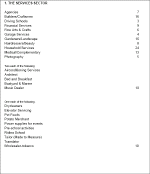 |
| 2. RETAIL (excl. pubs) | 36 |  |
| 3. I.T. / WEB SERVICES | 21 | |
| 4. PUBS / RESTAURANTS | 17 |
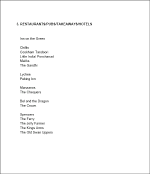
|
| 5. CONSULTANCY | 17 | |
| 6. MANUFACTURING | 9 |

|
| 7. OTHERS | 15 |
6.3 Results from postal/email B & E questionnaire Ė Oct 2006
Sample details
|
Sole trader |
10 |
|
1-5 employees |
14 |
|
6-9 employees |
6 |
|
10-19 employees |
3 |
|
Above 21 employees |
5 |
|
Total |
38 |
Type of business (Total Population)
|
Consultancy |
4 | 17 | |
|
Manufacturing |
2 | 8 | |
|
Service sector |
13 | 131 | |
|
Retail |
11 | 36 | |
|
IT |
1 | 21 | |
|
Pubs/restaurants |
3 | 17 | |
|
Agriculture |
1 | ? - | |
|
Musician |
1 | ?- | |
|
Totals |
38 (16%) | 245 | |
|
Located in |
|||
|
Cookham Village |
14 | ||
|
Cookham Dean |
10 | ||
|
Cookham Rise |
14 | ||
|
Although the sample is not large, it is a fairly good spread and so fairly representative.
|
|||
|
Qs1 and 2 |
|||
|
Most people in Cookham think their businesses will improve in the next 12 months/5years (it is the same number for both).
|
|||
|
Improve |
23 | ||
|
Stay the same |
15 | ||
|
TOTAL |
38 | ||
|
Qs 3 and 6 |
|
|
These are the factors that people think will positively assist their businesses- |
|
|
(Sample of 38) |
|
|
Increased car parking |
6 |
|
More interaction with other traders, |
|
|
Cookham Chamber of Commerce, |
|
|
CIM and John Lewis |
5 |
|
Business Directory |
5 |
|
Retain rail link |
3 |
|
More affordable housing |
3 |
|
Reduced crime |
3 |
|
Improved signage for tourists |
3 |
|
Controlled development |
3 |
|
Flexible planning |
2 |
|
Better Post Office/remains open |
2 |
|
Cash machine |
1 |
|
Q4 |
|
|
The positive aspects of doing business in Cookham. |
|
|
(Sample 38) |
|
|
Attractive for customers/beautiful |
10 |
|
Affluent/upmarket |
5 |
|
Community spirit/support |
7 |
|
Near M4/London/Heathrow |
6 |
|
Quiet |
2 |
|
6.4 Artistís visualisation of a future design for the Station Parade CONCEPT VISUAL ILLUSTRATION OF A DESIGN FOR STATION PARADE (click for larger image) |
6.5 Concept design proposals for the Station Parade
CONCEPT DESIGN PROPOSALS
Background:
The existing shops and car park adjacent to Cookham railway station was commented on by several of the sub-groups working on the Cookham Plan. The station acts as a gateway into the Cookhams for those arriving by train, and yet the design of the area around the station is out of keeping with the broader image of the Cookhams.
It is nevertheless an important resource for the Cookhams, containing the sort of everyday and practical shops that any community needs, compared to the rather more tourist and visitor orientated balance of shops, pubs and restaurants in Cookham Village.
Analysis of the existing buildings, car park and landscape context:
The architecture of Station Parade drew much comment during the preparation of the Cookham Plan, which is by present day standards somewhat uninspiring. It is neither high quality contemporary architecture nor a convincing retro design to blend in with the predominantly Victorian, Edwardian and 1930ís surroundings along Station Hill and High Road.
Visual unity Ė as well as shelter from rain - is provided by the continuous canopy over the front of the shops, although as shop signs have strayed higher up the frontages on to the fascia of the canopy the effect of the strong horizontal line is becoming broken up. Matching white weatherboarding has been replaced on some units above the shops with uPVC weatherboarding.
The same is true of window frames, as many of the original timber ones have been replaced with white uPVC frames.
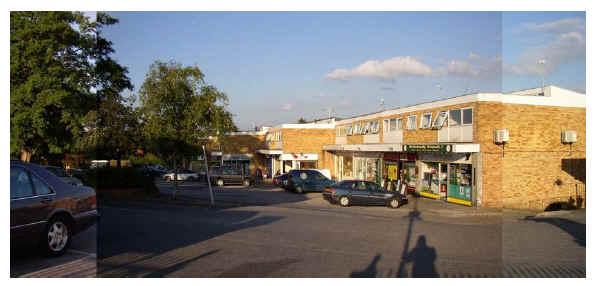
The condition of the car park is poor, with many patched up pot holes, areas of sunken paving, badly repaired retaining walls and raised planting beds containing unimaginative planting long overdue for some replacement. The mature trees however are a real benefit and have the scale to necessary to have a positive impact on the appearance.
It is apparent from large scale O.S. mapping - and from satellite views on Google Earth - how the parade sits in a sea of hard surfacing, compared to surrounding streets where there is much more Ďgreení, making those trees all the more significant.
Surfacing to the rear of the units is concrete, forming an impermeable barrier to rainwater reaching the sub-soil. With moves towards sustainable drainage solutions (SUDS) using permeable surfacing and below ground rainwater storage or infiltration to the sub-grade, this should be considered for some or all of the large hard surfaced area.
 There
are some meaningless details in the landscaping, and confusing use of
surface materials, for example at the corner of the station building,
where a road spur is terminated by a row of concrete bollards, the
footpath along Station Hill becomes the road surface without any
delineation.
There
are some meaningless details in the landscaping, and confusing use of
surface materials, for example at the corner of the station building,
where a road spur is terminated by a row of concrete bollards, the
footpath along Station Hill becomes the road surface without any
delineation.
Paved cut-throughs between the brick walled raised beds are blocked by car parking spaces, so crossing from Countrystore to the shops in the parade involves squeezing past cars or walking along the top of the low brick walls. The main entry/exit for cars doesnít provide a pedestrian route, although there is a wide path at the eastern end of the car park. When all the spaces in front of the shops are in use, the cars form a barrier, with no designated cut throughs or wheelchair friendly routes. A proportion of spaces should be designated for disabled use and be of larger dimensions, but there are none for the shops, and only one for the station at present.
Some of the parking is associated with the station, owned by Network Rail, and some of the spaces are now taken up with a local recycling facility. There is also a station car park on the other side of the railway line, which historically seems to be shared with the pub on the corner (now an Indian restaurant), the car repair garage and cars belonging to cottages along High Road. (The recently burnt out car had been left with the garage for repair.) There is also a BT public telephone box in the north east corner.
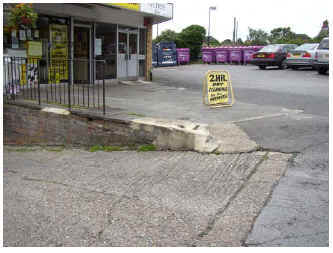 Back
in Station Parade, there is an awkward area of paving in front of the dry
cleaners and the Chinese takeaway, with strange changes of level and no
real separation from the road and parking surface. On the edge of this is
a horrible looking piece of retaining wall, apparently made out of mortar
rather than any proper building material.
Back
in Station Parade, there is an awkward area of paving in front of the dry
cleaners and the Chinese takeaway, with strange changes of level and no
real separation from the road and parking surface. On the edge of this is
a horrible looking piece of retaining wall, apparently made out of mortar
rather than any proper building material.
The road past the station has an old one-way sign, but generally all the parked cars are pointing in the opposite direction! A left turn out of this exit onto station Hill is difficult and hazardous.
Why this proposal is being produced:
A
concept design proposal has been commissioned in order to stimulate
discussion with various landowners and interested parties. It is not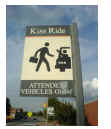 intended to be a fully worked out detail design scheme, but rather a look
at possible improvements to the visual impact of the area.
intended to be a fully worked out detail design scheme, but rather a look
at possible improvements to the visual impact of the area.
One issue is the idea of providing a transport interchange outside the station, for taxis and a bus route. This would probably be for a smaller size of single deck bus. Coupled with this would be the closing off of the narrow road outside the station, so there is one properly designed entry and exit for the car park and the station forecourt.
There would need to be a bus-turning space and bus stop, and also a kiss and ride lane outside the station. This turn-around and kiss & ride would be one way, but the rest of the car park circulation would be two way. Possible layouts for this layout are restricted if it is accepted that the mature trees should remain.
Whilst maintaining overall car parking provision, the main priorities are to improve the visual impact of the shop buildings and improve the layout, appearance and quality of the forecourt to the shops and the station for pedestrians. There is certainly scope to improve the design of the hard landscape to conform better to DDA requirements.
Dec 2007 final version
